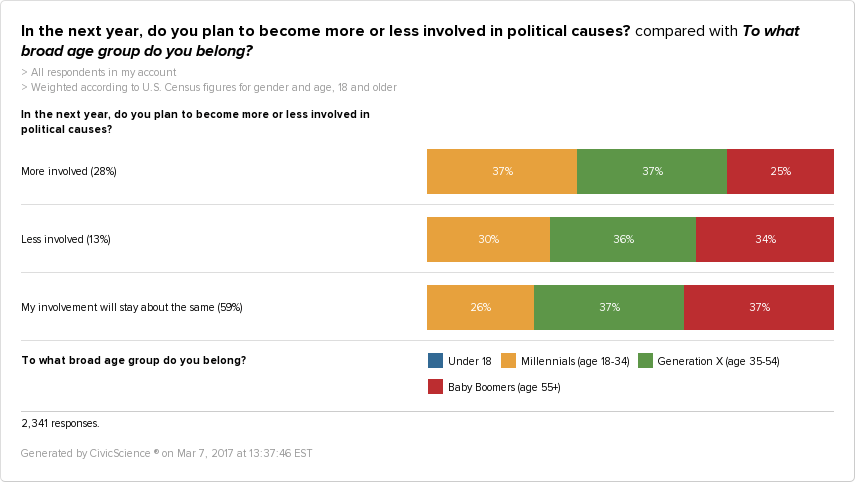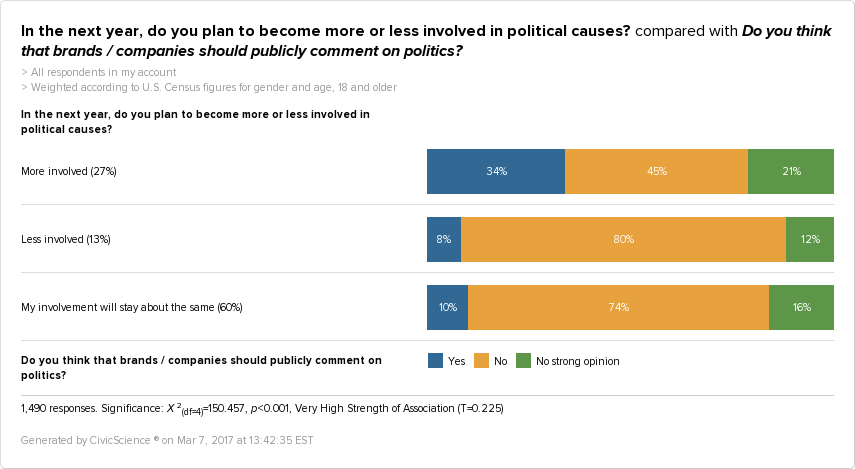We’re living in an increasingly political time. I didn’t think I’d live to see the day where news outlets report on the political leanings of New Balance. Nevertheless, here we are. Who should we expect will become more involved in political causes, in this day and age, when politics is never left out of a conversation?
It’s no surprise that increased engagement falls across party lines. Democrats are more than twice as likely to say they’ll be more involved with political causes in the next year. Conversely, Republicans are almost twice as likely to respond that they’ll be less involved in the next year.
What social causes can expect increased engagement?
When you dive into who plans to become more involved in political causes, the initiatives they’ll pursue becomes apparent. People who adjust their lifestyles to help the environment, buy locally grown food and use reusable grocery bags are more likely to say they’ll be made more engaged in political causes.
Environmental nonprofits especially should expect an uptick in involvement. Given the controversy around proposed environmental legislation, this shouldn’t come as a huge surprise.
What social causes can expect increased monetary support?
From our insights, it’s clear that people who want to become more involved with political causes are willing to take action on environmental issues and climate changes. However, this group also exhibits behaviors to indicate that certain charities or nonprofits can also expect an uptick in donations.
People who donate to health, culture and environmental charities are more likely to become more engaged in political causes over the next year. Since the election, nonprofits like the ACLU have seen historically large donations. Other causes and nonprofits in the health and culture sector should expect similar behaviors.
The next generation of political engagement
While this question trends toward party lines, there’s another distinguishing factor that should have all political causes excited. When it comes to age, 18-34-year-olds are more likely to say they’ll become more involved in the next year. On the other hand, 55+-year-olds are more likely to respond that their involvement will stay the same.
This data will surprise Millennial naysayers, but it’s encouraging across all party lines. Nonprofits and political causes should expect an influx of younger people getting involved. However, political involvement in 2017 may look different than some expect.
Social media = socially conscious
This new generation of politically engaged voters will look different than previous groups. Heavy social media users, Instagram users in particular, are interested in more political involvement. Technology trends and social media influence them. Consider the Women’s March in January. This movement was started largely by social media and resulted in one of the largest turnouts in US political history.
Causes will want to leverage social media to find a younger generation of voters who are looking for ways to engage with political causes. As mentioned above, the ACLU raised over $24 million in a single weekend, largely over Twitter.
#GrabYourWallet: political engagement can lead to profits
As we’ve discussed before, some brands will benefit from engaging politically with their customers. This data backs up this claim. People who are planning to become more involved with political causes are more likely to favor socially conscious businesses.
For this group, donating isn’t enough. Businesses who engage in socially conscious business practices, especially with an environmental focus, should expect to draw sales from this young group of politically minded consumers.











